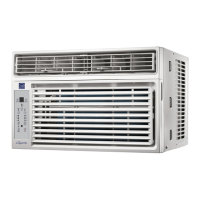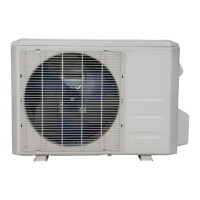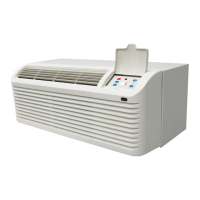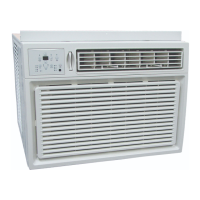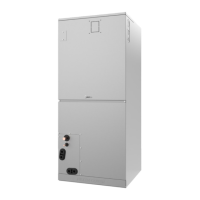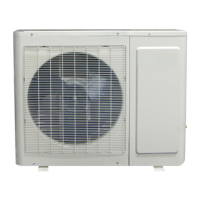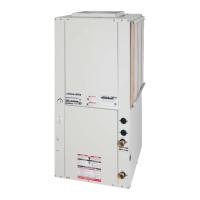
Do you have a question about the Mars Comfort-Aire Century HE Series and is the answer not in the manual?
| Brand | Mars |
|---|---|
| Model | Comfort-Aire Century HE Series |
| Category | Air Conditioner |
| Language | English |
Provides warnings and cautions regarding unit operation, handling, and installation safety.
Details essential steps and checks required before commencing unit installation.
Guidance on selecting appropriate indoor locations for horizontal units for service access.
Instructions for safely mounting horizontal units using provided hanger brackets.
Procedures for correctly installing and pitching condensate drain lines for horizontal units.
Guidelines for designing and installing ductwork for optimal unit airflow and performance.
Key guidelines for installing supply and return piping, including valve and strainer placement.
Step-by-step instructions for converting the air discharge from side to back.
Instructions for converting the air discharge from back to side.
Notes on the impossibility of field converting return air configurations due to piping.
Guidance on selecting appropriate mechanical room or closet locations for vertical units.
Methods for controlling sound, including unit placement and isolation pads.
Instructions for installing condensate lines for vertical units, noting internal traps.
Guidelines for supply/return piping, insulation, torque, and hose kit usage.
Details on different vFlow configurations: modulating valves and variable speed pumps.
Diagram illustrating a closed-loop application with an internal variable pump.
Diagram illustrating an open-loop application with an internal modulating valve.
Considerations for commercial systems, including air elimination and piping insulation.
Setting the DXM2 control's low water temperature limit for antifreeze systems.
Steps for marking and installing ground loops before construction begins.
Guidance on selecting appropriate materials and fittings for closed-loop ground source systems.
Recommendations for antifreeze type and concentration based on expected loop temperatures.
Description and illustration of open loop piping, including valve and material recommendations.
Guidelines for assessing water quality to prevent scaling, corrosion, and clogging.
Recommendations for sizing and selecting expansion tanks and pumps for system stability.
Guidance on selecting and installing water control valves to prevent mineral precipitation.
Ensuring available power matches unit specifications and compliance with electrical codes.
Instructions for rewiring the transformer for 230V supply on 208/230V units.
Details on connecting incoming line voltage wires to the unit's L side.
Wiring the thermostat to the DXM2 control board for unit operation.
Field selection of low water temperature limit for the DXM2 control via jumper.
Details on connecting accessory devices via terminals on the DXM2 control.
Proper placement and mounting of thermostats for accurate temperature measurement.
Table detailing blower performance including ESP, fan motor, and airflow settings.
Guidance on adjusting CFM settings to achieve rated airflow for AHRI testing.
Key for understanding symbols used in the single-phase wiring diagram.
Important notes and compliance information related to the wiring diagram.
Key for understanding symbols used in the three-phase wiring diagram.
Important notes and compliance information related to the wiring diagram.
Key for understanding symbols used in the 460 volt wiring diagram.
Important notes and compliance information related to the wiring diagram.
Configuration settings for DXM2 control via DIP packages and switches.
Details on the control's sequence of operation and safety checks during start-up.
Information on compatible thermostats and anticipated signal behavior.
Explanation of thermostat signal inputs and their recognition times.
Identification and purpose of various terminal blocks on the DXM2 control board.
Location and function of jumpers (JW1, JW3) and DIP switches (S1-S3) on the DXM2.
Details on accessory relays, compressor relay, and electric heat connections.
Notes regarding modulating valve/pump configuration and mounting hardware.
Defines the environmental and water temperature limits for proper unit operation.
Specifies initial start-up conditions for bringing spaces to occupancy temperatures.
Illustrations showing the open and closed positions of internal modulating valves.
Pre-power checks for unit electrical, fan, water, and control system integrity.
Pre-operation checks for system water temperature, pH, flushing, and controls.
Data table showing water pressure drop across the heat exchanger at various flow rates.
Table of operating pressures and temperatures for HE Series units.
Data on expected water temperature changes across the heat exchanger for different loops.
Schedule and procedures for cleaning water coils to maintain performance.
Maintenance considerations for HWG coils, especially in hard water conditions.
Importance of clean filters and recommended inspection and replacement frequency.
Procedures for cleaning condensate pans and drains to prevent issues.
Recommendation for annual amperage checks to ensure compressor health.
Guidance on fan motor lubrication and performance checks.
Instructions for cleaning air coils to maintain maximum performance.
Advice on preventing cabinet corrosion from water contact.
Guidelines for servicing the refrigerant circuit while maintaining sealed integrity.
Preliminary checks and inspection steps before using troubleshooting charts.
General guidelines for troubleshooting the DXM2 control board by verifying inputs/outputs.
Methods for verifying thermostat inputs and communication status with the DXM2.
Checking sensor inputs, including continuity and thermistor resistance measurements.
Verifying DXM2 outputs like compressor relays, alarm relays, and electric heat controls.
Procedure for entering the DXM2's 20-minute test mode for diagnostics.
Utilizing communicating thermostats or diagnostic tools for detailed DXM2 information.
A flowchart for diagnosing suspected problems using DXM2 fault recognition features.
Diagram and guidance for analyzing the heating cycle performance.
Diagram and guidance for analyzing the cooling cycle performance.
Details on warranty coverage, exceptions, and conditions for validity.
Information on warranty duration, remedies, liability limitations, and service procedures.
